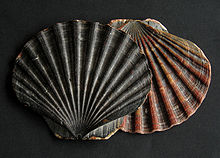Pecten (małże)
|
Grzebień Zakres czasowy:
|
|
|---|---|

|
|
| Dwie zużyte na plaży górne zastawki Pecten maximus z klasyfikacji Wales | |
| Scientific | |
| Królestwo: | Animalia |
| Gromada: | mięczak |
| Klasa: | Bivalvia |
| Zamówienie: | pektynida |
| Rodzina: | Pectinidae |
| Rodzaj: |
Pecten OF Müller , 1776 |
Pecten to rodzaj dużych przegrzebków lub małży morskich, morskich małży z rodziny Pectinidae , przegrzebków. Jest to rodzaj rodzaju rodziny.
Rodzaj ten znany jest w zapisie kopalnym od kredy do czwartorzędu (przedział wiekowy: od 70,6 do 0,0 mln lat temu). Muszle kopalne tego rodzaju znajdowano na całym świecie.
Etymologia
Nazwa Pecten pochodzi od łacińskiego słowa oznaczającego grzebień lub grabie . Od 1904 roku Pecten jest podstawą logo firmy naftowej Shell .
Gatunek
Gatunki z rodzaju Pecten obejmują:
- P. albicans (Schröter, 1802)
- P. afribenedictus Kilburn & Dijkstra 1995
- P. alcesianus † McLearn 1933
- P. alfa † Dall 1898
- P. argillensis † Conrad 1860
- P. assinboiensis † Russell & Landes 1937
- P. aurantiacus Roding 1798
- P. aztecus † Bose 1906
- P. barretti † Seeley 1861
- P. bifidus † Menke 1843
- P.biddleana † Kellum 1926
- P. cadwalladerensis † McLearn 1942
- P. ceibanus † Cooke 1928
- P. coderensis † Harris 1927
- P. collapsus † Biały 1887
- P. coralliphila † Olsson 1922
- P. danicus Chemnitz 1795
- P. deformis † Tate 1887
- P. dendyi † Hutton 1902
- P. dentatus Sowerby 1829
- P. disparatus † Drewno 1882
- P. elixatus † Conrad 1846
- P. excavatus Anton, 1838
- P. expansus † Smith 1847
- P. flemingianus † de Koninck 1863
- P. fumata †
- P. fumatus Reeve 1852
- P. gramamensis † Maury 1930
- P. grapteus † Maury 1924
- P. hemphillii † Dall 1879
- P. humphreysii † Conrad 1842
- P. inaequalis † Cossmann & Lambert 1884
- P. jacobaeus Linneusz , 1758
- P. kokcharofi † de Verneuil 1845
- P. lowei Hertlein 1935
- P. maximus Linneusz , 1758
- P. mclellani † Gibson 1987
- P. mediacostatus † Hanna 1926
- P. membranosus † Morton 1834
- P. mendenhalli † Arnold 1906
- P. nearchi † Vredenburg 1928
- Pecten nigromagnus † Sacco 1897
- P. novaezelandiae Reeve 1853
- P. nugenti † Brązowy 1913
- P. obsoletus Proporzec 1777
- P. palmipes † Tate 1886
- P. paradezii † d'Orbigny 1842
- P. pascoei † Cox 1936
- P. pictus † Cossmann & Lambert 1884
- P. pielgrzymi † Cox 1936
- P. plebeia † Lamarck 1806
- P. politus † Gemmellaro 1896
- P. pontiamnis † McLearn 1942
- P. pseudosolarium † Hassan 1953
- P. ptychotis † M'Coy 1847
- P. raoulensis Powell 1958
- P. sanctiludovici † Anderson i Martin 1914
- P. santarosanus † Bose 1905
- P. saskatchewanensis † Warren 1934
- P. scintillatus † Conrad 1865
- P. seabeensis † Richards 1947
- P. sealyi † Richards 1947
- P. sedanensis † Martin 1909
- P. silentiensis † McLearn 1926
- P. squamula † Lamarck 1806
- P. striatus Müller 1776
- P. subrufus Proporzec 1777
- P. sulcicostatus Sowerby II, 1842
- P. suwanneensis † Dall 1898
- P. thaumastus † Maury 1924
- P. triradiatus Müller 1776
- P. tyaughtonae † McLearn 1942
- P. vasseli † Fuchs 1878
- P. vaughani † Cooke 1919
- P. vigintisulcatus † Müller 1776
- P. wendelli † Tucker 1934
- P. yessoensis Jay, 1857
Bibliografia
- Frank HT Rodes, Herbert S. Zim i Paul R. Shaffer (1993) - Natuurgids Fossielen (ontstaan, preparren en rangschikken van fossielen), Zuidnederlandse Uitgeverij NV, Aartselaar. ISBN D-1993-0001-361
- Cyril Walker & David Ward (1993) - Fossielen: Sesam Natuur Handboeken, Bosch & Keuning, Baarn. ISBN 90-246-4924-2
